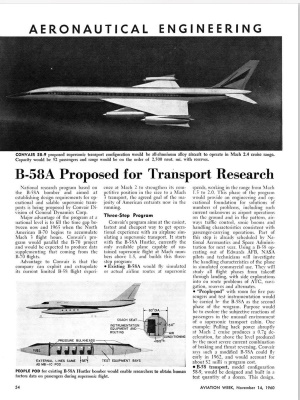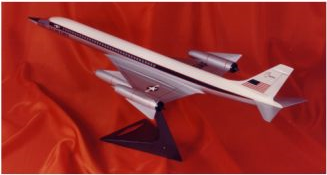For your enjoyment this April 1st, and in conjunction with TimothyC, we proudly present:
The Convair 1010 is an American turbofan-powered supersonic transport (SST) aircraft that was operated until 2015. Derived from the B-58 Hustler bomber, the Convair 1010 had a maximum speed over twice the speed of sound at Mach 2.4 (1840 mph or 2,963 km/h), with seating for 52 passengers. First flown in 1967, the Convair 1010 entered service in 1969 and continued flying for the next 46 years. It is one of the original three supersonic transports to have operated commercially; the other two being the Anglo-French Concorde and the Soviet-built Tu-144. The smallest but fastest of the initial three supersonic transports, the Convair 1010 was intended as a flying testbed for operations of a larger and even faster American supersonic transport, the Boeing 2707, and optimized for domestic American supersonic transport. However, the more advanced aircraft was cancelled in 1971 with only two prototypes partially completed, and domestic American supersonic flights were banned the same year. Forty-one Convair 1010 airframes were built, thirty-seven customer aircraft and four flight test aircraft, two of which were later operated by NASA. Pan American World Airways (PanAm) and its successor Delta Air Lines were the main airlines to purchase and fly the Convair 1010, earning it the unofficial nickname of the “Last Clipper,” though several other airlines at one point operated small fleets of the Convair 1010, including Japan Airlines, Air India, and Virgin Sonic. IranAir was the last airline to retire the type. Two aircraft, designated VC-7A by the United States Air Force, were often operated as Air Force One on overseas diplomatic trips, sharing the call sign with two Boeing VC-25A…
Early Studies
Convair originally proposed the conversion of the B-58 Hustler for passenger airliner service in November 1960, in a three-phase program which would have seen operations of the B-58 in simulated overland supersonic flights, the modification of a B-58 munitions/fuel pod into a small passenger cabin to test reactions to supersonic flight, and then the construction of a specially-built B-58 derived aircraft, the Convair Model 58-9. While the second phase “people pod” was never built, the B-58 was used alongside other supersonic aircraft like the F-104 in the controversial 1964 Oklahoma city sonic boom tests which helped spell the end of American overland supersonic flight, while the Convair 58-9 was the earliest ancestor of the final Convair 1010. However, at the time, the government was not interested in developing such a limited supersonic aircraft…
...The situation for supersonic transport development in the United States changed rapidly with the formalization of arrangements between Aerospatiale and BAC to develop the Concorde SST in 1962. FAA director Najeeb Halaby had advocated for funding of an American SST since 1961, but it had been blocked by concerns about economics. With the Anglo-French project proceeding and word emerging of the Soviet Tu-144, a consensus emerged within the FAA and industry that if American manufacturers did not lead in the supersonic market, it would be “a stunning setback” as Halaby put it. Halaby joined Vice President Lyndon B. Johnson in drafting an American response to the Concorde. To avoid surrendering the lead to foreign efforts, two Requests for Proposal (RFPs) were issued in 1963 following Congressional and Presidential approval of the National Supersonic Transport program. One was for a plane larger, faster, and more advanced than the Soviet and Anglo-French entrants, which would offer the potential of bringing supersonic flight to the masses. The other was for an aircraft which could be ready before international competitors to “fill the gap” and allow American airlines and manufacturers to “get in on the ground floor” of supersonic commercial operations. The policy was known, informally, as “the heir and the spare.” Proposals for both programs were received in January 1964, though most companies focused their attention on the larger and more lucrative airframe. Convair’s proposal for the “immediate capability’ aircraft was one of only a few entrants, competing with a version of the XB-70 Valkyrie and a few other low-risk options. However, while the Valkyrie had only two prototypes under construction and had yet to make its first flight, the B-58 was in operational service and had finally seen many of its initial teething issues resolved. It has been alleged that the plan to build the Convair proposal at their Fort Worth plant was a key deciding factor: both FAA director Najeeb Halaby and then-President Johnson hailed from the state of Texas, and Convair was in financial trouble following the commercial failure of their Convair 990 aircraft. Though fast, the Convair 990 Coronado was expensive to operate and had low seating capacity, and only 37 aircraft were built before lack of interest led to the model’s discontinuation in 1963, resulting in corporate parent General Dynamic suffering one of the largest losses in American corporate history. The selection of the Convair proposal, renamed as the Convair 1010 to indicate its heritage within Convair’s civilian passenger line, was alleged to be a form of corporate bailout for a critical Texas-based production site. The selection was extremely rapid, with the contract announced in July of 1964 with a goal of first flight by the beginning of 1967. The larger SST contract wouldn’t be downselected to the Boeing 2707 for more than two years, with delivery not expected before 1975. The launch of the Convair 1010 was reputed to be a major deciding factor in PanAm’s Juan Trippe placing options on both American aircraft instead of the Concorde, a pattern which was followed by several other American firms. Others, looking for the earliest supersonic aircraft they could find, placed options on both the Concorde and the Convair 1010s. The race for supersonic flight was on...
Design and Development
...Design of the Convair 1010 began almost immediately, consisting of many of the same team which had just succeeded in delivering the Convair 990A to meet American Airlines’ goal of the fastest subsonic airliner in service. The design of the Convair 1010 was based heavily on the B-58 Hustler bomber and the Model 58-9 proposal, and consists of a delta wing with conventional tail surfaces and four engine pods. However, the outboard engine pods were relocated from their location on the B-58 to the ends of the wings, minimizing interaction drag with the wing and suppressing tip vortex generation. This was assisted by two wingtip fins, antecedents of the “winglets'' of modern subsonic jetliners. Designed to be capable of domestic short-haul supersonic service once the larger planned SST came into service, the Convair 1010 was originally designed to use the J-58 turbojet engine, which resulted in a relatively short range of just 2,500 nautical miles (4,600 kilometers) at its designed top speed of Mach 2.4. Though this was 20% faster than the Anglo-French Concorde, it would require a fuel stop on all flights to Europe to be made in Iceland, resulting in similar overall travel time. However, Convair’s recent experiences with the Model 990 Coronado lead to the 1010 switching to four turbofan CJ-805-23D engines, a slightly uprated version of the engine used on the Convair 990. This unusual engine featured the addition of an aft-mounted low-bypass fan driven directly from fan blades extended from a turbine stage which turned freely within the exhaust of an otherwise lightly-modified CJ-805--itself a derivative of the J-79 used on the B-58, simplifying mounting them to the aircraft. Already capable of Mach 0.97 operation on the Convair 990’s CJ-805-23B turbofan, a redesigned inlet based on the B-58 allowed the CJ-805D to handle the supersonic airflow while delivering superior thrust and fuel efficiency compared to the original military J-79 engines. The switch from a pure turbojet to a turbofan helped boost the Convair 1010’s range to just over 6,000 kilometers, allowing the elimination of the Iceland fuel stop on many Atlantic trips. Passengers were carried in twenty-six (26) rows of two seats each, with the aisle running down the middle. This meant every seat had access to two of the plane’s relatively small windows, including a single window in each of the plane’s two midships lavatories. A flight crew of three was required to operate the plane, with two flight attendants offering service during the flight. The design was finalized in 1965, by which time concern and controversy was emerging about its domestic short-haul role…

Diagram from Jet Aircraft Power Systems 3rd Edition by J. V. Casamassa, R. D. Bent, p238. Image via @stevphfeniey
Controversy and Construction
During the first half of 1964, the FAA organized a program with the USAF to generate 8 sonic booms a day over Oklahoma City using F-104, F-106, and B-58 aircraft. Though much of the population adapted to the noise, a significant fraction did not, and significant damage claims were reported due to broken glass and other property damage. Later in 1964, testing on the prototype XB-70 showed that higher altitude flights of larger aircraft, which NASA had hoped would mitigate the boom problem, instead exacerbated it, resulting in the aircraft dragging a “boom carpet” over 40 kilometers wide the length of its trip. Over the next year, public opinion would build against the option of domestic overland supersonic travel, restricting the Convair 1010 and the newly-selected Boeing 2707 to overseas international travel. This reduced much of the market for the planes, and raised concerns over their economic viability. In spite of concerns about the plane’s operational and economic viability, the first Convair 1010 prototypes began production at Fort Worth Plant #4 in the summer of 1966. Construction was streamlined by the reuse of tooling originally developed for the B-58 mass production run. By that point, Convair had taken over 50 options for the Convair 1010, many from customers who had also ordered either the Boeing 2707 or the Concorde…
...The Convair 1010 made its first flight on November 2, 1967, becoming the first of the new generation of supersonic transports to take flight. Over the next year, the envelope of the aircraft was explored, with the Convair 1010 making its first supersonic flight over the Texas panhandle in June of 1968. Late in the year, a second prototype joined the test fleet. Many of the initial test pilots were drawn from pilots who had flown the B-58 in development or squadron service, and all stated the new plane was significantly easier to fly. The improved engines offered enhanced reliability, and redesigned cockpit layout and control system monitoring reduced the crew workload compared to the B-58, though it was still complex compared to any other commercial aircraft. For more than a year, Convair racked up flight hours on the two prototypes. Observers from the press, the FAA, NASA, and Boeing monitored the tests--the latter as part of the often-uneasy cooperation forced by the FAA on the two chosen US supersonic flag carriers. With the Convair 1010 celebrating its first year in test flights, Boeing was forced to reluctantly return to the drawing board, trading their elegant swing wing for a more conventional delta. The major overhaul drew comparisons between the two FAA-sponsored projects. Some complimented President Johnson and FAA Director Najeeb Halaby for their foresight in ensuring that the United States had not “bet the farm” on a single aircraft, while others complained that for the cost of the two programs, the United States would still have no single aircraft capable of matching the Concorde and Tu-144 until and unless Boeing could completely overhaul the 2707’s design direction. The third prototype became active in November, almost a month before the Soviet Tu-144 became the second of the SSTs to take flight. A Convair team in Los Angeles was reputed to have sent the Tupolev team a card wishing them well and offering congratulations on introducing the fourth supersonic transport ever built. Four months later, the Concorde would follow the other two aircraft into testing…
...By the spring of 1969, the test fleet had swelled to four prototype aircraft and the first two production-intent aircraft. The benefits of the B-58 heritage showed, as the Convair 1010 was able to rapidly move through testing and additional aircraft could be added to the test fleet by transitioning pilots with B-58 Hustler experience. The FAA type certificate was issued in the fall of 1969, and the first aircraft were delivered to PanAm who used them to inaugurate the first supersonic trans-Atlantic airline service....
Service
...Flying with the jetstream, PanAm’s Convair 1010s were able to reach some European destinations unrefueled from PanAm’s Worldport in New York, even when sustaining the type’s top speed of Mach 2.4. However, on the return westbound leg the same winds worked against the plane and due to early struggles with inlet issues operating the CJ-805-23D in supersonic flight, almost all flights were forced to make a two-leg return, stopping at Keflavík Airport in Iceland for fuel before continuing. Even with the stop, PanAm’s Convair 1010 “Clippers” could make a passage time of little more than three hours. By 1971, PanAm was flying ten departures a day, typically with full cabins, from JFK for London, Paris, and Frankfurt. With the initial deliveries of ten aircraft to PanAm and four to the US government, Convair turned to fulfill orders from airlines who had placed smaller orders. Japan Airlines (JAL) took delivery of a trio of Convair 1010s in 1971, and initiated the first Pacific supersonic service, making a fuel stop in Anchorage…
... The oil crises of 1973 raised serious questions for the economic viability of the Convair 1010 and its competitors, which had yet to reach delivery to airline operations. Only routes like PanAm’s Atlantic service which could routinely fill almost all of the Convair 1010’s 56 seats with paying customers seemed likely to be profitable as fuel prices skyrocketed. Convair had an order book of 75 aircraft in 1971, but by the end of 1973, cancellations had begun to mount. While some airlines like PanAm were still interested in more aircraft, other airlines like United, American, Qantas, and Lufthansa began to cancel their orders shortly before taking delivery. In 1971, Convair had confidently predicted that the Convair 1010 line would remain open and produce a dozen planes a year for “a decade or more”. However, by the end of 1973 they were beginning to scale down operations. PanAm, having evaluated the Convair 1010 against the Concorde, had decided to stake their operations on the smaller, faster, easier-to-fill aircraft, and had declined to order a second supersonic type. Instead, to begin Pacific service, they bought the final year’s production as the airlines they were originally ordered by cancelled delivery…
...The final Convair 1010 was produced in Fort Worth in 1975, with the line closing after building a total of just 41 aircraft--four prototypes and 37 operational aircraft. Three of the last sold were delivered to IranAir, which used them for service around the Middle East and to France and Germany. As with the Model 880 and 990, it seemed that in the new era of turbofan widebody subsonic aircraft, speed was no longer king in commercial operations. Convair’s second-most-produced civilian aircraft, it would also be the company's last, though they would produce fuselage sections for McDonnell Douglas. The supersonic services of PanAm, JAL, and Air India would remain luxury status indicators for the super-rich. The Boeing 2707, the planned American follow-on to the Convair 1010, never reached flight. The smaller Concorde fleet would duel the Convair 1010 for dominance on Atlantic routes, but the Convair 1010 would rule Pacific routes. PanAm’s Convair 1010 Clippers flew from San Francisco to Hawaii, then on to Tokyo (with fuel stop at Midway Island) and Australia (with fuel stop in American Samoa), while JAL maintained service to Los Angeles and Vancouver through Anchorage...
…During the Mexican Oil boom in 1977, PanAm inaugurated a gulf service, flying a shuttle service from New York to Miami, then a triangle route between Houston, Mexico City, and Miami, with two flights a day each direction. The service was popular as long as the boom lasted, but by the mid-1980s had been withdrawn leaving only the JFK-to-Miami shuttle…
...By the end of the 1980s, though Iran Air continued to own their two aircraft and operated them on an irregular schedule, and some airlines experimented with wet-leased aircraft for limited engagements, every major airline other than PanAm had withdrawn their Convair 1010s from regular service. PanAm’s 25 aircraft were widely advertised as “the largest supersonic fleet in the world”. Four aircraft were operated by USAF Military Airlift Command, two of which were kept on standby as “Air Force One” for Presidential use. NASA had purchased two of Convair’s in-house testing fleet for experiments with high-Mach-number flight including aerodynamic tests of models, deployment of payloads, and techniques to attempt to minimize the “sonic boom” of future generations of supersonic aircraft. One aircraft was modified in 1989 with a long nose attempting early efforts at “boom shaping”...
...Engine intake and combustor modifications installed in the PanAm fleet during their first round of D-checks in the early to mid 1980s improved fuel efficiency slightly. The gains, though small, added a few hundred additional kilometers of range, enough to allow Convair 1010s to make the JFK-to-Europe leg unrefueled both ways in almost all weather conditions and to eliminate the fuel stop at Midway Atoll on flights between Japan and Hawaii, though Hawaii to Sydney still required a refueling stop...
..In 1991, when PanAm became financially insolvent, the Atlantic and Pacific supersonic services were two of the company’s major profit centers, and were acquired by Delta in the buyout of the company’s assets, though the more expensive Sydney service was discontinued. The Delta services continued to be reduced from the PanAm peak, with the Miami shuttle eliminated in 1993 and all Pacific service beyond Hawaii eliminated in 1996 as the Japanese financial collapse reduced the profitability of Tokyo-bound supersonic flights, leaving only SFO-to-Hawaii and the JFK-to-Europe services…
...In 1998, cracks were found in the inboard wing pylons of a Delta Convair 1010 during its second “D-check” maintenance period. A stand-down followed, and cracks were found in the pylons and fuselages of five more aircraft. Though the JFK-based Atlantic service resumed in 1999, reduced available aircraft led to the final discontinuation of Delta’s Convair 1010 Pacific service…
Upgrades and Successors
...In the mid-1980s, PanAm had begun discussions with Convair and McDonnell-Douglas about the potential for upgrades to modernize their Convair 1010 Clipper fleet. The range of the Convair 1010 and the resulting need for additional fuel stops in Iceland and various Pacific islands had contributed to the plane having operational limitations. Despite being only capable of Mach 2 instead of the Convair 1010’s Mach 2.4, the shorter total distance of a direct flight on British Airways and Air France’s Concorde meant that the slower plane was often equally as quick or even faster to cross the Atlantic than the American plane, though PanAm’s larger fleet of smaller planes meant they could offer more flexibility in departure time and destinations while remaining profitable. General Electric proposed replacing their older CJ-805-23 turbofans with a new supersonic turbofan based on the CFM-56’s F101-heritage core. Ultimately, Convair, McDonnell, and PanAm couldn’t make the cost of developing and fielding a brand new supersonic engine in life-limited airframes economically viable…
...Instead of developing a re-engining option for the Convair 1010, Convair instead proposed developing an entirely new airframe, as the profitability of the Convair 1010 in the booming late 1980s and early 1990s sparked hope for hundreds of new supersonic sales, particularly if NASA’s development work could indeed yield a design capable of overland supersonic flight. McDonnell inherited sole ownership of the “Convair 2020” studies when they purchased Convair’s fuselage production assets and certain design authorities from General Dynamics during Convair’s 1992 breakup. With maintenance costs of Concorde rising, British Airways and Air France also expressed interest in the “MD-2020”, and interest was also received from Richard Branson’s Virgin Atlantic. When McDonnell merged with Boeing in 1996, the project was reborn as the Boeing 2020, and approved as the corporate inheritor of the company’s Boeing 2707 legacy. At long last, the Boeing company would produce the advanced second American supersonic airliner. Though delayed by the post-9/11 slump in air travel, Delta’s Convair 1010 service saw dramatically increased demand following the fatal Air France 4590 in 2000, helping to prove passengers were still willing to selectively choose the speed of supersonic airliners on at least certain routes. This was highlighted by the success of Virgin Sonic, a branded “airline within an airline” project by Richard Branson’s Virgin Group and Delta Air Lines from 1999 to 2008. Virgin Sonic operated aircraft leased from Delta as well as former Air India and JAL aircraft on summer holiday routes in competition with Concorde. The Boeing 2020 made its first flight in 2007, and was introduced into service with Delta in 2010, with Delta retiring its final Convair 1010 aircraft one-to-one with their replacements…
...The last Convair 1010s flying commercially belonged to Iran Air, which operated their pair intermittently until 2013. NASA’s two remaining aircraft were operated as testbeds until they were replaced by Boeing 2020s in 2015, though one was kept flight-worthy until it delivered itself to the Air Mobility Command Museum at Dover AFB in Dover, Delaware in 2018 in the last flight of a Convair 1010...
Convair 1010 Cultural Legacy
With the cancellation of the Boeing 2707, the Convair 1010 and the Boeing 747 ended up representing the height of American aviation technology during the 1970s. They were often compared to the Apollo program, and they had connections to several Apollo astronauts. In one likely apocryphal story, astronaut Pete Conrad was flying on a PanAm Convair 1010 Clipper chartered for a worldwide promotional and diplomatic tour following the Apollo 12 mission to the moon. Conrad is reputed to have spent the entire flight riding in the cockpit jumpseat, and requested several times to take the stick. Supposedly, Conrad cited his supersonic flight time in F-4 Phantoms and Apollo, saying that “you may think it’s impressive to do Miami to New York in an hour, but I’ve done Miami to Spain in ten minutes.” The story’s provenance is questionable, though it was recreated in a scene in HBO’s miniseries From the Earth to the Moon and Pete Conrad did eventually get checked out as a pilot on the NASA Convair 1010 testbed fleet before his retirement...
..Other Apollo astronauts had more complicated histories with the Convair 1010. Though he admired Convair’s technical achievement, Frank Borman intervened personally to prevent Eastern Airlines from moving forward with Convair 1010 and Concorde purchases in 1973, selling the airline’s options on the 1010 to PanAm instead as he was unconvinced of the type’s economic viability from the beginning and was worried it would be little more than a showpiece for the airline’s management…
…The West Wing episode “Slow Boat to San Francisco” (Season 1, Episode 5), famously called out the limited capacity of the VC-7A in its role as Air Force One. A scheduling problem forces the President to make a flight from Washington to California in the VC-7A with Leo, leaving the staff split between two planes when a developing situation throws the “airborne White Houses” into a crisis. Sam, Josh, and CJ are forced to deal with the press while flying about the 747 VC-25A, with limited ability to contact the President after a scheduling problem forces the President to make a flight from Washington to California in a Convair 1010 with Leo. In the episode, Bartlet alludes to the impending retirement of the Convair 1010 as Air Force One (which had actually happened 18 months prior in reality), asking Leo “Why don’t we do this more often? I love this plane. It’s from when we used to dream of the stars.” Leo answers by citing the President’s own arguments for signing an Air Force spending bill the month prior to terminate support of the VC-7A transport fleet, including that “the people of Dayton and Peoria don’t think much of the President laying down a sonic boom because the scheduler forgot to convert to California time.” Bartlet grimaces, then leans back in his seat. “Always the details.”...
...The exterior of Convair 1010s and recreated cabin interiors have appeared in several dramas set in the last half of the 20th century, when the Convair 1010 and Concorde were the height of luxury in travel times. Advertising campaigns for the Convair 1010 appeared as a plot thread in the period-piece drama “Mad Men” in 2009, including filming in a redressed Delta Convair 1010 in storage on display at the Pima Air Museum in Arizona...
Operators:
Pan American Airways: 25 (1969-1991)
Delta Air Lines: 25+ (Former Pan American, Air India, Japan Airlines) (1992-2012)
Japan Airlines: 3 (1971-1993)
Iran Air: 3 (1971-2013)
Air India: 2 (1972-1995)
Virgin Sonic: 3 (further 2 under wet-lease from Delta Air Lines) (1999-2008)
USAF: 4 (1970-1999)
NASA: 3 (Convair Test Aircraft #3, #4, former USAF) (1972-2018)
Federal Express: 2 (Under Wet-Lease from Pan American) (1984-1990)
Hawaiian Airlines: 1 (Under Wet-Lease from Pan American) (1988)
Aircraft on Display:
Sample Livery
Convair Original Testing Colors

Air Force One (VC-7A)
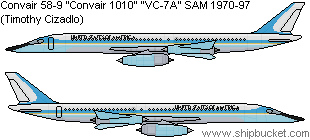
USAF (C-7B)
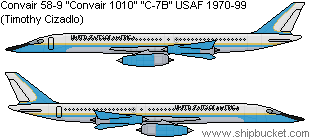
Pan American

Japan Airlines
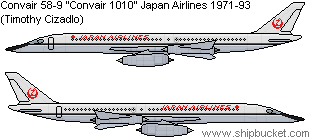
Iran Air
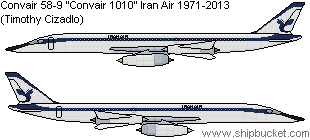
Air India
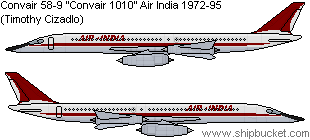
Delta
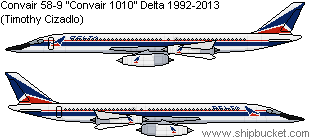
Federal Express
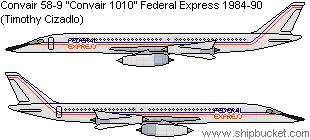
Virgin Sonic

Boeing 1010

NASA “Worm”
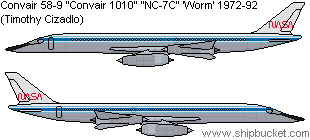
NASA “Meatball”
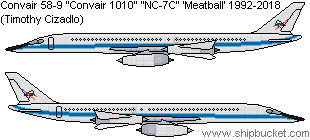
NASA One
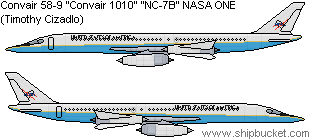
Additional image source and inspirations by “agnott” on DeviantArt:
Model 58-9/Convair 1010 in Delta Livery by Agnott, used in opening wikibox
Agnott’s proposed PanAm livery
Agnott’s proposed Virgin Atlantic livery
The Last of the Clippers: The Convair 1010
A wikibox timeline
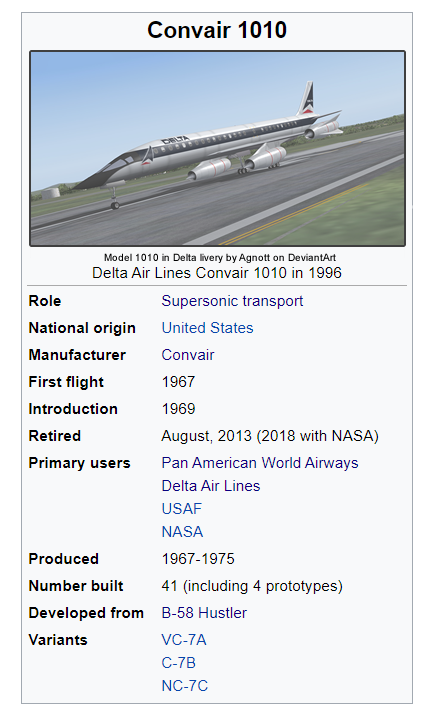
A wikibox timeline

The Convair 1010 is an American turbofan-powered supersonic transport (SST) aircraft that was operated until 2015. Derived from the B-58 Hustler bomber, the Convair 1010 had a maximum speed over twice the speed of sound at Mach 2.4 (1840 mph or 2,963 km/h), with seating for 52 passengers. First flown in 1967, the Convair 1010 entered service in 1969 and continued flying for the next 46 years. It is one of the original three supersonic transports to have operated commercially; the other two being the Anglo-French Concorde and the Soviet-built Tu-144. The smallest but fastest of the initial three supersonic transports, the Convair 1010 was intended as a flying testbed for operations of a larger and even faster American supersonic transport, the Boeing 2707, and optimized for domestic American supersonic transport. However, the more advanced aircraft was cancelled in 1971 with only two prototypes partially completed, and domestic American supersonic flights were banned the same year. Forty-one Convair 1010 airframes were built, thirty-seven customer aircraft and four flight test aircraft, two of which were later operated by NASA. Pan American World Airways (PanAm) and its successor Delta Air Lines were the main airlines to purchase and fly the Convair 1010, earning it the unofficial nickname of the “Last Clipper,” though several other airlines at one point operated small fleets of the Convair 1010, including Japan Airlines, Air India, and Virgin Sonic. IranAir was the last airline to retire the type. Two aircraft, designated VC-7A by the United States Air Force, were often operated as Air Force One on overseas diplomatic trips, sharing the call sign with two Boeing VC-25A…
Early Studies
Convair originally proposed the conversion of the B-58 Hustler for passenger airliner service in November 1960, in a three-phase program which would have seen operations of the B-58 in simulated overland supersonic flights, the modification of a B-58 munitions/fuel pod into a small passenger cabin to test reactions to supersonic flight, and then the construction of a specially-built B-58 derived aircraft, the Convair Model 58-9. While the second phase “people pod” was never built, the B-58 was used alongside other supersonic aircraft like the F-104 in the controversial 1964 Oklahoma city sonic boom tests which helped spell the end of American overland supersonic flight, while the Convair 58-9 was the earliest ancestor of the final Convair 1010. However, at the time, the government was not interested in developing such a limited supersonic aircraft…
...The situation for supersonic transport development in the United States changed rapidly with the formalization of arrangements between Aerospatiale and BAC to develop the Concorde SST in 1962. FAA director Najeeb Halaby had advocated for funding of an American SST since 1961, but it had been blocked by concerns about economics. With the Anglo-French project proceeding and word emerging of the Soviet Tu-144, a consensus emerged within the FAA and industry that if American manufacturers did not lead in the supersonic market, it would be “a stunning setback” as Halaby put it. Halaby joined Vice President Lyndon B. Johnson in drafting an American response to the Concorde. To avoid surrendering the lead to foreign efforts, two Requests for Proposal (RFPs) were issued in 1963 following Congressional and Presidential approval of the National Supersonic Transport program. One was for a plane larger, faster, and more advanced than the Soviet and Anglo-French entrants, which would offer the potential of bringing supersonic flight to the masses. The other was for an aircraft which could be ready before international competitors to “fill the gap” and allow American airlines and manufacturers to “get in on the ground floor” of supersonic commercial operations. The policy was known, informally, as “the heir and the spare.” Proposals for both programs were received in January 1964, though most companies focused their attention on the larger and more lucrative airframe. Convair’s proposal for the “immediate capability’ aircraft was one of only a few entrants, competing with a version of the XB-70 Valkyrie and a few other low-risk options. However, while the Valkyrie had only two prototypes under construction and had yet to make its first flight, the B-58 was in operational service and had finally seen many of its initial teething issues resolved. It has been alleged that the plan to build the Convair proposal at their Fort Worth plant was a key deciding factor: both FAA director Najeeb Halaby and then-President Johnson hailed from the state of Texas, and Convair was in financial trouble following the commercial failure of their Convair 990 aircraft. Though fast, the Convair 990 Coronado was expensive to operate and had low seating capacity, and only 37 aircraft were built before lack of interest led to the model’s discontinuation in 1963, resulting in corporate parent General Dynamic suffering one of the largest losses in American corporate history. The selection of the Convair proposal, renamed as the Convair 1010 to indicate its heritage within Convair’s civilian passenger line, was alleged to be a form of corporate bailout for a critical Texas-based production site. The selection was extremely rapid, with the contract announced in July of 1964 with a goal of first flight by the beginning of 1967. The larger SST contract wouldn’t be downselected to the Boeing 2707 for more than two years, with delivery not expected before 1975. The launch of the Convair 1010 was reputed to be a major deciding factor in PanAm’s Juan Trippe placing options on both American aircraft instead of the Concorde, a pattern which was followed by several other American firms. Others, looking for the earliest supersonic aircraft they could find, placed options on both the Concorde and the Convair 1010s. The race for supersonic flight was on...
Design and Development
...Design of the Convair 1010 began almost immediately, consisting of many of the same team which had just succeeded in delivering the Convair 990A to meet American Airlines’ goal of the fastest subsonic airliner in service. The design of the Convair 1010 was based heavily on the B-58 Hustler bomber and the Model 58-9 proposal, and consists of a delta wing with conventional tail surfaces and four engine pods. However, the outboard engine pods were relocated from their location on the B-58 to the ends of the wings, minimizing interaction drag with the wing and suppressing tip vortex generation. This was assisted by two wingtip fins, antecedents of the “winglets'' of modern subsonic jetliners. Designed to be capable of domestic short-haul supersonic service once the larger planned SST came into service, the Convair 1010 was originally designed to use the J-58 turbojet engine, which resulted in a relatively short range of just 2,500 nautical miles (4,600 kilometers) at its designed top speed of Mach 2.4. Though this was 20% faster than the Anglo-French Concorde, it would require a fuel stop on all flights to Europe to be made in Iceland, resulting in similar overall travel time. However, Convair’s recent experiences with the Model 990 Coronado lead to the 1010 switching to four turbofan CJ-805-23D engines, a slightly uprated version of the engine used on the Convair 990. This unusual engine featured the addition of an aft-mounted low-bypass fan driven directly from fan blades extended from a turbine stage which turned freely within the exhaust of an otherwise lightly-modified CJ-805--itself a derivative of the J-79 used on the B-58, simplifying mounting them to the aircraft. Already capable of Mach 0.97 operation on the Convair 990’s CJ-805-23B turbofan, a redesigned inlet based on the B-58 allowed the CJ-805D to handle the supersonic airflow while delivering superior thrust and fuel efficiency compared to the original military J-79 engines. The switch from a pure turbojet to a turbofan helped boost the Convair 1010’s range to just over 6,000 kilometers, allowing the elimination of the Iceland fuel stop on many Atlantic trips. Passengers were carried in twenty-six (26) rows of two seats each, with the aisle running down the middle. This meant every seat had access to two of the plane’s relatively small windows, including a single window in each of the plane’s two midships lavatories. A flight crew of three was required to operate the plane, with two flight attendants offering service during the flight. The design was finalized in 1965, by which time concern and controversy was emerging about its domestic short-haul role…

Diagram from Jet Aircraft Power Systems 3rd Edition by J. V. Casamassa, R. D. Bent, p238. Image via @stevphfeniey
Controversy and Construction
During the first half of 1964, the FAA organized a program with the USAF to generate 8 sonic booms a day over Oklahoma City using F-104, F-106, and B-58 aircraft. Though much of the population adapted to the noise, a significant fraction did not, and significant damage claims were reported due to broken glass and other property damage. Later in 1964, testing on the prototype XB-70 showed that higher altitude flights of larger aircraft, which NASA had hoped would mitigate the boom problem, instead exacerbated it, resulting in the aircraft dragging a “boom carpet” over 40 kilometers wide the length of its trip. Over the next year, public opinion would build against the option of domestic overland supersonic travel, restricting the Convair 1010 and the newly-selected Boeing 2707 to overseas international travel. This reduced much of the market for the planes, and raised concerns over their economic viability. In spite of concerns about the plane’s operational and economic viability, the first Convair 1010 prototypes began production at Fort Worth Plant #4 in the summer of 1966. Construction was streamlined by the reuse of tooling originally developed for the B-58 mass production run. By that point, Convair had taken over 50 options for the Convair 1010, many from customers who had also ordered either the Boeing 2707 or the Concorde…
...The Convair 1010 made its first flight on November 2, 1967, becoming the first of the new generation of supersonic transports to take flight. Over the next year, the envelope of the aircraft was explored, with the Convair 1010 making its first supersonic flight over the Texas panhandle in June of 1968. Late in the year, a second prototype joined the test fleet. Many of the initial test pilots were drawn from pilots who had flown the B-58 in development or squadron service, and all stated the new plane was significantly easier to fly. The improved engines offered enhanced reliability, and redesigned cockpit layout and control system monitoring reduced the crew workload compared to the B-58, though it was still complex compared to any other commercial aircraft. For more than a year, Convair racked up flight hours on the two prototypes. Observers from the press, the FAA, NASA, and Boeing monitored the tests--the latter as part of the often-uneasy cooperation forced by the FAA on the two chosen US supersonic flag carriers. With the Convair 1010 celebrating its first year in test flights, Boeing was forced to reluctantly return to the drawing board, trading their elegant swing wing for a more conventional delta. The major overhaul drew comparisons between the two FAA-sponsored projects. Some complimented President Johnson and FAA Director Najeeb Halaby for their foresight in ensuring that the United States had not “bet the farm” on a single aircraft, while others complained that for the cost of the two programs, the United States would still have no single aircraft capable of matching the Concorde and Tu-144 until and unless Boeing could completely overhaul the 2707’s design direction. The third prototype became active in November, almost a month before the Soviet Tu-144 became the second of the SSTs to take flight. A Convair team in Los Angeles was reputed to have sent the Tupolev team a card wishing them well and offering congratulations on introducing the fourth supersonic transport ever built. Four months later, the Concorde would follow the other two aircraft into testing…
...By the spring of 1969, the test fleet had swelled to four prototype aircraft and the first two production-intent aircraft. The benefits of the B-58 heritage showed, as the Convair 1010 was able to rapidly move through testing and additional aircraft could be added to the test fleet by transitioning pilots with B-58 Hustler experience. The FAA type certificate was issued in the fall of 1969, and the first aircraft were delivered to PanAm who used them to inaugurate the first supersonic trans-Atlantic airline service....
Service
...Flying with the jetstream, PanAm’s Convair 1010s were able to reach some European destinations unrefueled from PanAm’s Worldport in New York, even when sustaining the type’s top speed of Mach 2.4. However, on the return westbound leg the same winds worked against the plane and due to early struggles with inlet issues operating the CJ-805-23D in supersonic flight, almost all flights were forced to make a two-leg return, stopping at Keflavík Airport in Iceland for fuel before continuing. Even with the stop, PanAm’s Convair 1010 “Clippers” could make a passage time of little more than three hours. By 1971, PanAm was flying ten departures a day, typically with full cabins, from JFK for London, Paris, and Frankfurt. With the initial deliveries of ten aircraft to PanAm and four to the US government, Convair turned to fulfill orders from airlines who had placed smaller orders. Japan Airlines (JAL) took delivery of a trio of Convair 1010s in 1971, and initiated the first Pacific supersonic service, making a fuel stop in Anchorage…
... The oil crises of 1973 raised serious questions for the economic viability of the Convair 1010 and its competitors, which had yet to reach delivery to airline operations. Only routes like PanAm’s Atlantic service which could routinely fill almost all of the Convair 1010’s 56 seats with paying customers seemed likely to be profitable as fuel prices skyrocketed. Convair had an order book of 75 aircraft in 1971, but by the end of 1973, cancellations had begun to mount. While some airlines like PanAm were still interested in more aircraft, other airlines like United, American, Qantas, and Lufthansa began to cancel their orders shortly before taking delivery. In 1971, Convair had confidently predicted that the Convair 1010 line would remain open and produce a dozen planes a year for “a decade or more”. However, by the end of 1973 they were beginning to scale down operations. PanAm, having evaluated the Convair 1010 against the Concorde, had decided to stake their operations on the smaller, faster, easier-to-fill aircraft, and had declined to order a second supersonic type. Instead, to begin Pacific service, they bought the final year’s production as the airlines they were originally ordered by cancelled delivery…
...The final Convair 1010 was produced in Fort Worth in 1975, with the line closing after building a total of just 41 aircraft--four prototypes and 37 operational aircraft. Three of the last sold were delivered to IranAir, which used them for service around the Middle East and to France and Germany. As with the Model 880 and 990, it seemed that in the new era of turbofan widebody subsonic aircraft, speed was no longer king in commercial operations. Convair’s second-most-produced civilian aircraft, it would also be the company's last, though they would produce fuselage sections for McDonnell Douglas. The supersonic services of PanAm, JAL, and Air India would remain luxury status indicators for the super-rich. The Boeing 2707, the planned American follow-on to the Convair 1010, never reached flight. The smaller Concorde fleet would duel the Convair 1010 for dominance on Atlantic routes, but the Convair 1010 would rule Pacific routes. PanAm’s Convair 1010 Clippers flew from San Francisco to Hawaii, then on to Tokyo (with fuel stop at Midway Island) and Australia (with fuel stop in American Samoa), while JAL maintained service to Los Angeles and Vancouver through Anchorage...
…During the Mexican Oil boom in 1977, PanAm inaugurated a gulf service, flying a shuttle service from New York to Miami, then a triangle route between Houston, Mexico City, and Miami, with two flights a day each direction. The service was popular as long as the boom lasted, but by the mid-1980s had been withdrawn leaving only the JFK-to-Miami shuttle…
1978 Route Maps

GCMap for Western Hemisphere Service, 1978
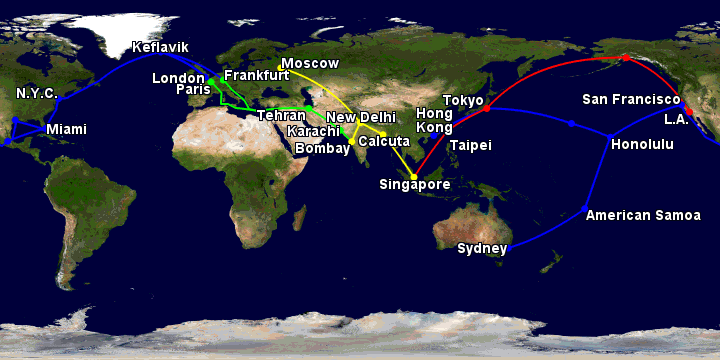
GCMap for Eastern Hemisphere Service, 1978

GCMap for Western Hemisphere Service, 1978

GCMap for Eastern Hemisphere Service, 1978
...By the end of the 1980s, though Iran Air continued to own their two aircraft and operated them on an irregular schedule, and some airlines experimented with wet-leased aircraft for limited engagements, every major airline other than PanAm had withdrawn their Convair 1010s from regular service. PanAm’s 25 aircraft were widely advertised as “the largest supersonic fleet in the world”. Four aircraft were operated by USAF Military Airlift Command, two of which were kept on standby as “Air Force One” for Presidential use. NASA had purchased two of Convair’s in-house testing fleet for experiments with high-Mach-number flight including aerodynamic tests of models, deployment of payloads, and techniques to attempt to minimize the “sonic boom” of future generations of supersonic aircraft. One aircraft was modified in 1989 with a long nose attempting early efforts at “boom shaping”...
...Engine intake and combustor modifications installed in the PanAm fleet during their first round of D-checks in the early to mid 1980s improved fuel efficiency slightly. The gains, though small, added a few hundred additional kilometers of range, enough to allow Convair 1010s to make the JFK-to-Europe leg unrefueled both ways in almost all weather conditions and to eliminate the fuel stop at Midway Atoll on flights between Japan and Hawaii, though Hawaii to Sydney still required a refueling stop...
..In 1991, when PanAm became financially insolvent, the Atlantic and Pacific supersonic services were two of the company’s major profit centers, and were acquired by Delta in the buyout of the company’s assets, though the more expensive Sydney service was discontinued. The Delta services continued to be reduced from the PanAm peak, with the Miami shuttle eliminated in 1993 and all Pacific service beyond Hawaii eliminated in 1996 as the Japanese financial collapse reduced the profitability of Tokyo-bound supersonic flights, leaving only SFO-to-Hawaii and the JFK-to-Europe services…
...In 1998, cracks were found in the inboard wing pylons of a Delta Convair 1010 during its second “D-check” maintenance period. A stand-down followed, and cracks were found in the pylons and fuselages of five more aircraft. Though the JFK-based Atlantic service resumed in 1999, reduced available aircraft led to the final discontinuation of Delta’s Convair 1010 Pacific service…
Upgrades and Successors
...In the mid-1980s, PanAm had begun discussions with Convair and McDonnell-Douglas about the potential for upgrades to modernize their Convair 1010 Clipper fleet. The range of the Convair 1010 and the resulting need for additional fuel stops in Iceland and various Pacific islands had contributed to the plane having operational limitations. Despite being only capable of Mach 2 instead of the Convair 1010’s Mach 2.4, the shorter total distance of a direct flight on British Airways and Air France’s Concorde meant that the slower plane was often equally as quick or even faster to cross the Atlantic than the American plane, though PanAm’s larger fleet of smaller planes meant they could offer more flexibility in departure time and destinations while remaining profitable. General Electric proposed replacing their older CJ-805-23 turbofans with a new supersonic turbofan based on the CFM-56’s F101-heritage core. Ultimately, Convair, McDonnell, and PanAm couldn’t make the cost of developing and fielding a brand new supersonic engine in life-limited airframes economically viable…
...Instead of developing a re-engining option for the Convair 1010, Convair instead proposed developing an entirely new airframe, as the profitability of the Convair 1010 in the booming late 1980s and early 1990s sparked hope for hundreds of new supersonic sales, particularly if NASA’s development work could indeed yield a design capable of overland supersonic flight. McDonnell inherited sole ownership of the “Convair 2020” studies when they purchased Convair’s fuselage production assets and certain design authorities from General Dynamics during Convair’s 1992 breakup. With maintenance costs of Concorde rising, British Airways and Air France also expressed interest in the “MD-2020”, and interest was also received from Richard Branson’s Virgin Atlantic. When McDonnell merged with Boeing in 1996, the project was reborn as the Boeing 2020, and approved as the corporate inheritor of the company’s Boeing 2707 legacy. At long last, the Boeing company would produce the advanced second American supersonic airliner. Though delayed by the post-9/11 slump in air travel, Delta’s Convair 1010 service saw dramatically increased demand following the fatal Air France 4590 in 2000, helping to prove passengers were still willing to selectively choose the speed of supersonic airliners on at least certain routes. This was highlighted by the success of Virgin Sonic, a branded “airline within an airline” project by Richard Branson’s Virgin Group and Delta Air Lines from 1999 to 2008. Virgin Sonic operated aircraft leased from Delta as well as former Air India and JAL aircraft on summer holiday routes in competition with Concorde. The Boeing 2020 made its first flight in 2007, and was introduced into service with Delta in 2010, with Delta retiring its final Convair 1010 aircraft one-to-one with their replacements…
...The last Convair 1010s flying commercially belonged to Iran Air, which operated their pair intermittently until 2013. NASA’s two remaining aircraft were operated as testbeds until they were replaced by Boeing 2020s in 2015, though one was kept flight-worthy until it delivered itself to the Air Mobility Command Museum at Dover AFB in Dover, Delaware in 2018 in the last flight of a Convair 1010...
Convair 1010 Cultural Legacy
With the cancellation of the Boeing 2707, the Convair 1010 and the Boeing 747 ended up representing the height of American aviation technology during the 1970s. They were often compared to the Apollo program, and they had connections to several Apollo astronauts. In one likely apocryphal story, astronaut Pete Conrad was flying on a PanAm Convair 1010 Clipper chartered for a worldwide promotional and diplomatic tour following the Apollo 12 mission to the moon. Conrad is reputed to have spent the entire flight riding in the cockpit jumpseat, and requested several times to take the stick. Supposedly, Conrad cited his supersonic flight time in F-4 Phantoms and Apollo, saying that “you may think it’s impressive to do Miami to New York in an hour, but I’ve done Miami to Spain in ten minutes.” The story’s provenance is questionable, though it was recreated in a scene in HBO’s miniseries From the Earth to the Moon and Pete Conrad did eventually get checked out as a pilot on the NASA Convair 1010 testbed fleet before his retirement...
..Other Apollo astronauts had more complicated histories with the Convair 1010. Though he admired Convair’s technical achievement, Frank Borman intervened personally to prevent Eastern Airlines from moving forward with Convair 1010 and Concorde purchases in 1973, selling the airline’s options on the 1010 to PanAm instead as he was unconvinced of the type’s economic viability from the beginning and was worried it would be little more than a showpiece for the airline’s management…
…The West Wing episode “Slow Boat to San Francisco” (Season 1, Episode 5), famously called out the limited capacity of the VC-7A in its role as Air Force One. A scheduling problem forces the President to make a flight from Washington to California in the VC-7A with Leo, leaving the staff split between two planes when a developing situation throws the “airborne White Houses” into a crisis. Sam, Josh, and CJ are forced to deal with the press while flying about the 747 VC-25A, with limited ability to contact the President after a scheduling problem forces the President to make a flight from Washington to California in a Convair 1010 with Leo. In the episode, Bartlet alludes to the impending retirement of the Convair 1010 as Air Force One (which had actually happened 18 months prior in reality), asking Leo “Why don’t we do this more often? I love this plane. It’s from when we used to dream of the stars.” Leo answers by citing the President’s own arguments for signing an Air Force spending bill the month prior to terminate support of the VC-7A transport fleet, including that “the people of Dayton and Peoria don’t think much of the President laying down a sonic boom because the scheduler forgot to convert to California time.” Bartlet grimaces, then leans back in his seat. “Always the details.”...
...The exterior of Convair 1010s and recreated cabin interiors have appeared in several dramas set in the last half of the 20th century, when the Convair 1010 and Concorde were the height of luxury in travel times. Advertising campaigns for the Convair 1010 appeared as a plot thread in the period-piece drama “Mad Men” in 2009, including filming in a redressed Delta Convair 1010 in storage on display at the Pima Air Museum in Arizona...
Operators:
Pan American Airways: 25 (1969-1991)
Delta Air Lines: 25+ (Former Pan American, Air India, Japan Airlines) (1992-2012)
Japan Airlines: 3 (1971-1993)
Iran Air: 3 (1971-2013)
Air India: 2 (1972-1995)
Virgin Sonic: 3 (further 2 under wet-lease from Delta Air Lines) (1999-2008)
USAF: 4 (1970-1999)
NASA: 3 (Convair Test Aircraft #3, #4, former USAF) (1972-2018)
Federal Express: 2 (Under Wet-Lease from Pan American) (1984-1990)
Hawaiian Airlines: 1 (Under Wet-Lease from Pan American) (1988)
Aircraft on Display:
| Museum | Location | Livery | Notes |
| National Air and Space Museum, Steven F. Udvar-Hazy Center | Dulles Airport, Chantilly, Virginia | Pan American | First PanAm operational Aircraft, Retired 1998 after Fuselage Cracks found during D-Check |
| Air Mobility Command Museum | Dover Air Force Base, Delaware | NASA “Meatball” | Former USAF, NASA, Final Flight, 2018 |
| Delta Flight Museum | Atlanta, Georgia | Delta | Former PanAm |
| National Museum of the United States Air Force | Wright-Patterson Air Force Base, Dayton, Ohio | Air Force One | 70-1020 "SAM Ten-Twenty" |
| Richard Nixon Presidential Library and Museum | Yorba Linda, California | Air Force One | 70-1010 "SAM Ten-Ten" |
| Intrepid Air, Sea, & Space Museum | New York City, New York | Virgin Sonic | Former PanAm, Former Delta, Retired after Virgin Sonic discontinued |
| Pima Air & Space Museum | Tucson, Arizona | Pan American, Non-Aviation Grade | Retired Delta, Repainted for filming, cabin interior loosely refit to 1970s configuration |
| Fantasy of Flight | Polk City, Florida | NASA "Worm" | Former Convair #3, Former NASA, Retired 1988. Features modifications aimed at reducing sonic boom profile. |
| California Science Center | Los Angeles, California | Delta | Shares Temporary Pavilion with OV-105 Endeavour |
| Louis A. Turpen Aviation Museum/San Francisco Airport Commission Aviation Library | San Francisco Airport, San Francisco, California | Delta | Joint Exhibit with NASA Ames, Holds absolute top speed record, Commercial Airliner, 3000 kph. |
| Evergreen Aviation & Space Museum | McMinnville, Oregon | Virgin Sonic | Record Holder, Honolulu to Sydney |
| Kansas Cosmosphere | Hutchinson, Kansas | Delta | Record Holder, Miami to JFK, set in July 1987 |
| Museum of Flight | Seattle, Washington | "Boeing 1010" | Paint Scheme Anachronistic, Former Air India |
| Fort Worth Aviation Museum | Fort Worth, Texas | Convair 1010 | Convair test aircraft #1, no Revenue or government service. Stored at Davis-Monthan 1977-2002 |
| Museum of Science and Industry | Chicago, Illinois | Delta | Record Holder, Fastest PanAm/Delta Tokyo-SFO run |
| Tehran Aerospace Exhibition Center | Tehran, Iran | Iran Air | Last Commercial Flight |
| Musée de l’air et de l’espace | Paris–Le Bourget Airport, Le Bourget, France | Delta | Outside Display with Boeing 747 |
| Brooklands Museum | Weybridge, Surrey, England | Delta | On Display with Concorde |
| Daniel K. Inouye International Airport | Honolulu, Hawai'i | Delta | Viewing platforms from both secured and unsecured areas between Terminal 1 and Terminal 2 |
| Aviation Museum of Iceland | Akureyi, Iceland | Virgin Sonic | |
| Auto & Technik Museum | Sinsheim, Germany | Pan American | Only Convair 1010 on display with Tu-144 and Concorde |
| JAL Sky Museum | Haneda Airport, Tokyo, Japan | JAL | Only example in Japan, Former JAL, Former Virgin Sonic |
| Indian Air Force Museum | Palam, India | Air India | Only Example in India |
Sample Livery
Convair Original Testing Colors

Air Force One (VC-7A)

USAF (C-7B)

Pan American

Japan Airlines

Iran Air

Air India

Delta

Federal Express

Virgin Sonic

Boeing 1010

NASA “Worm”

NASA “Meatball”

NASA One

Additional image source and inspirations by “agnott” on DeviantArt:
Model 58-9/Convair 1010 in Delta Livery by Agnott, used in opening wikibox
Agnott’s proposed PanAm livery
Agnott’s proposed Virgin Atlantic livery
Last edited:
